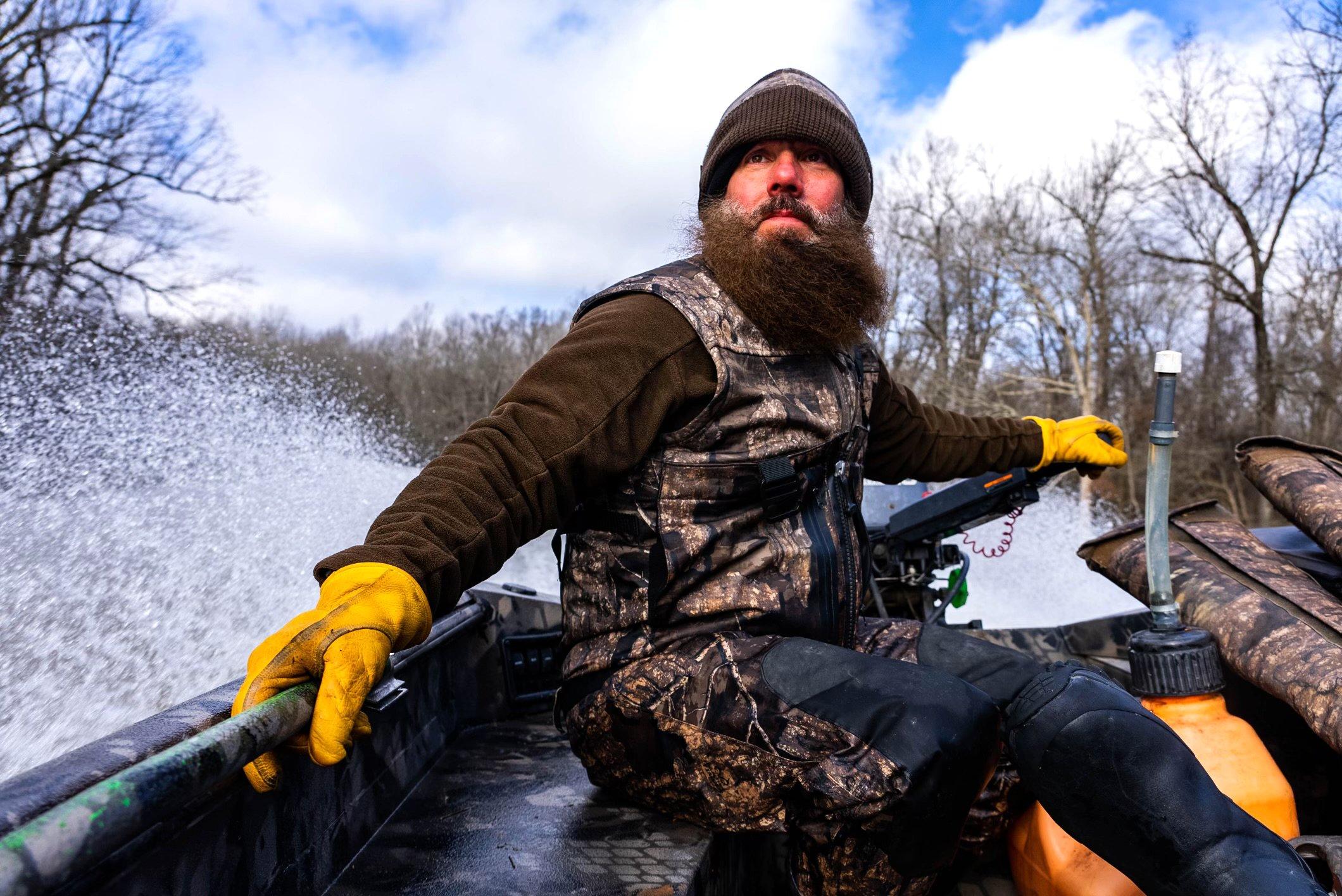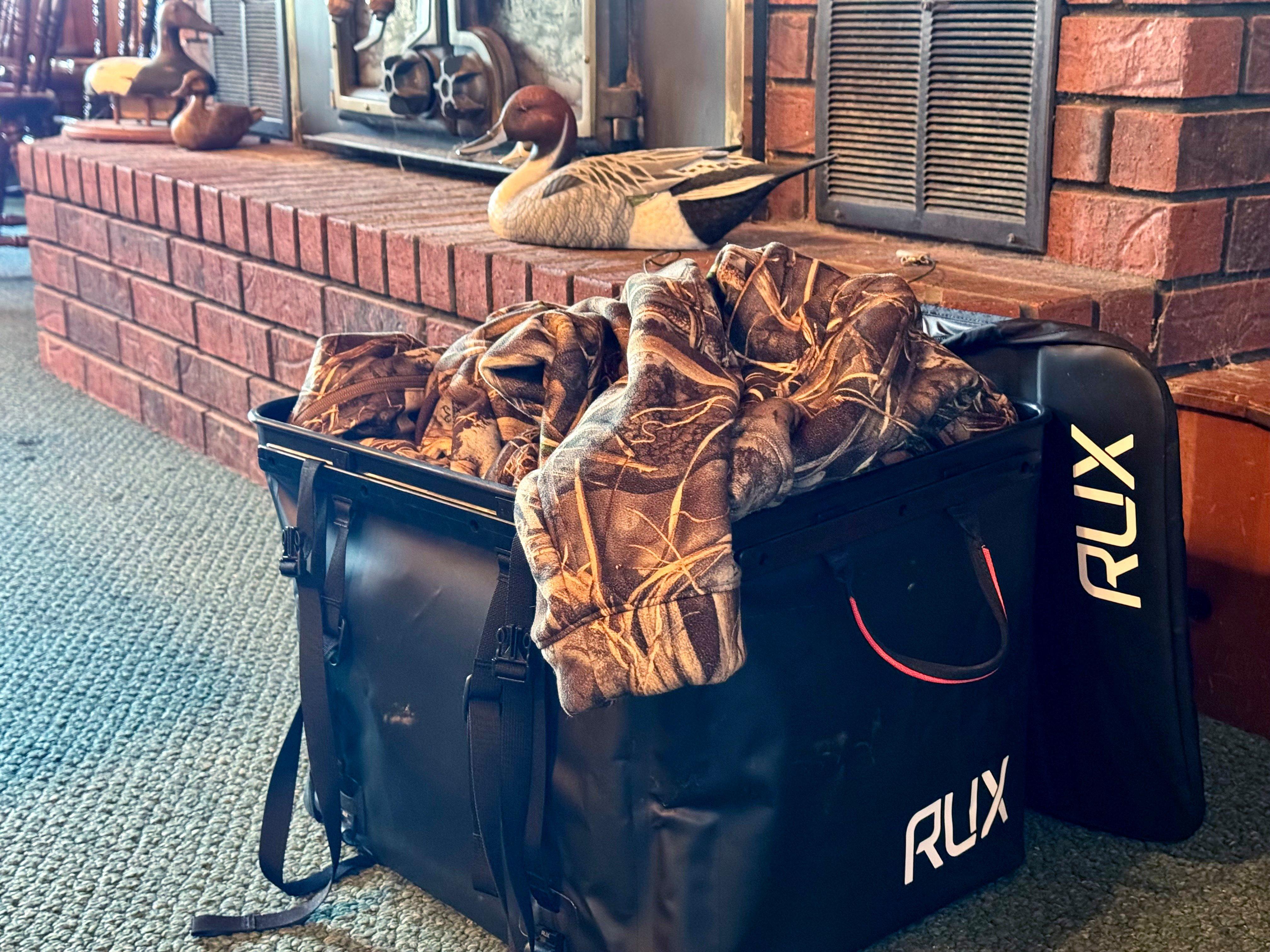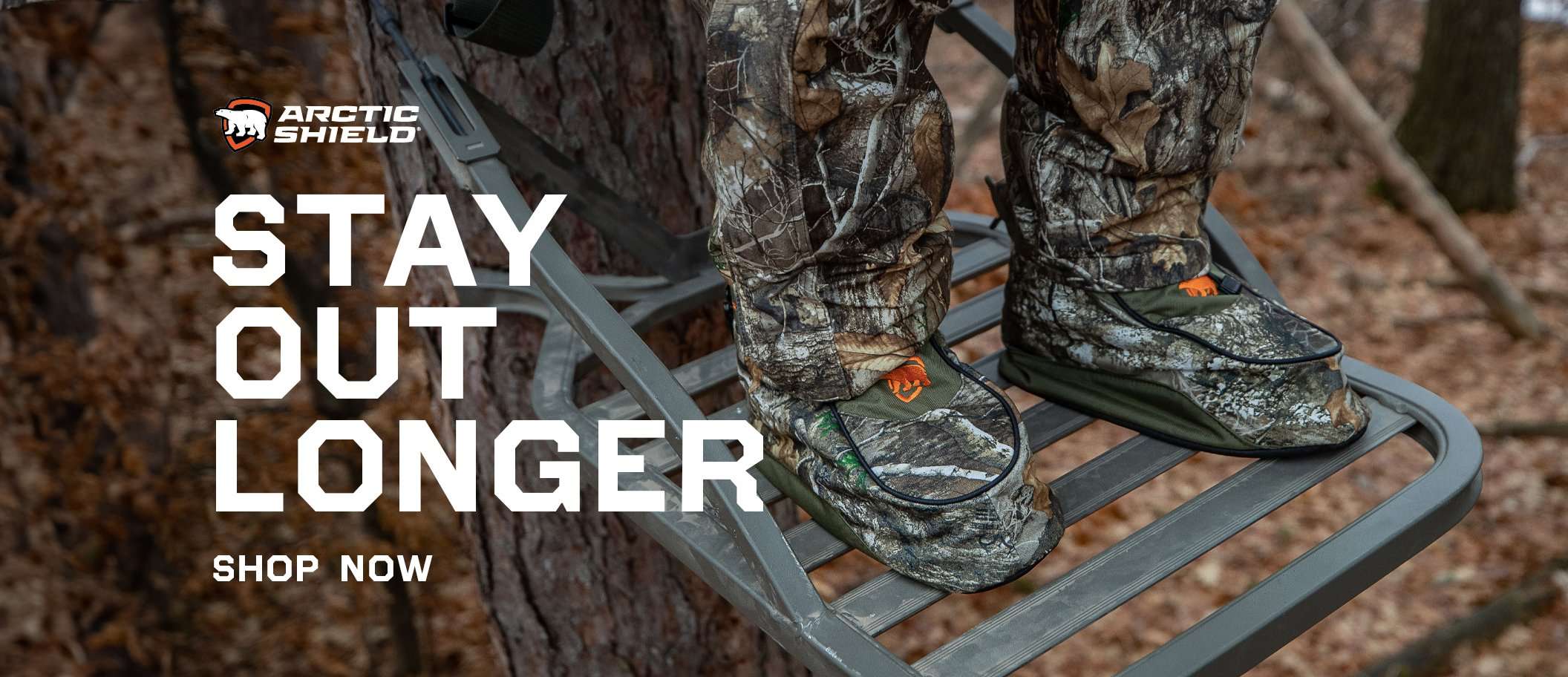Not just a matter of comfort, extreme cold during a duck hunt can be a matter of life or death. Here’s how to stay warm in a duck blind, no matter the conditions
Waterfowlers are a strange lot. When normal folks see a weather forecast that includes snow and ice, extreme temperature drops, and a strong north wind, they find something to do inside that day. When duck and goose hunters see that same forecast, they get excited.

Waterfowling is one of the only sports that gets better as weather conditions get worse. Dressing correctly will keep you warm no matter what the weather does. Image by Billy Campbell
But being outdoors, and in a boat in cold water in particular, during extreme weather conditions can be dangerous. We’ve all heard and read about the great Armistice Day storm on that November day in 1940 when duck hunters across the Midwest saw conditions rapidly decline from 50 degrees to high-wind blizzard conditions. Many were stranded. Wind chill temperatures plummeted to negative 50 degrees or lower that night. At least 50 duck hunters perished.
Even today, with modern advancements in clothing, boats and communication gear, stories of duck hunters not making it back home are all too common. So how do you dress to stay warm no matter what the weather does?
***Don’t Miss: *IS DUCK HUNTING REALLY IN DECLINE?
LAYER UP
Billy Campbell, Realtree Ambassador and star of the Dr Duck YouTube series Billy Campbell has been chasing ducks for 45 years. He said layering is the most important thing when you are dressing for cold weather. “The best thing about layering is that you can take it on or off depending on your activity level. That way you don’t sweat and soak yourself from the inside while you are trying to put out decoys with all your clothes on. I’ll put everything on for the boat trip in, then shed some layers for putting out decoys, then layer back up when we start hunting,” Campbell said.

Dressing in layers allows hunters to tailor insulation needs to tasks like cold boat rides or warm hikes into spots. Image by Billy Campbell
Base Layer
It starts at the bottom. The base layer you choose to place closest to your skin is one of the most important parts of staying warm. There’s an old saying that cotton kills. Cotton holds moisture and stops insulating the moment it gets damp. Avoid it for cold weather gear. While there are many modern materials on the market, wool still rules for most hard core duck hunters. Wool layers, like the Pro Tech from Ibex, outperforms just about every other material because of the fiber shape. Wool fibers have natural kinks and bends, and they trap air to keep your body warm. Since wool is a poor conductor of heat, it holds your body’s warmth inside. It even insulates when it gets damp.
Campbell likes wool, but he says not to overlook more modern technologies. “When it’s really cold, I’ve got some electric heated base layers that work amazingly well. I took a spill into the water a couple years ago during some really cold weather. I took off my waders, dumped the water out, put them back on, and turned on the heated base layer. It kept me warm all morning. I’ve had good luck with heated socks as well,” he added.
Mid Layer
The mid layer provides more insulation to hold your body heat in. A wool sweater or an insulated hoodie is my choice for the upper body. For pants, I switch to more modern materials. Banded Thacha Insulated Men’s Pants carry a whopping 100 grams of Primaloft insulation while not being bulky and still stretching to allow movement. Another good choice is the fleece lined ArcticShield Prodigy Vapor Pant. Both of these are moisture wicking, pulling excess sweat away from your body while you are active, and water resistant, keeping you dry in bad conditions.
Outer Layer
This is where modern materials shine. Realtree Men's MAX-7 Waterfowl Insulated Bibs are my go to for 100 % waterproof warmth. The bib design helps to hold in heat around the body core, keeping your internal organs warm and functioning.
Top the bibs with a good waterproof parka like the ArcticShield Tundra 3-In-1 Parka with a removable zip out fleece vest and Retain heat retention technology. The durable outer shell stands up to brush and briars and keeps the rain out while holding your body heat in. Realtree Waterfowl Editor Brian Lovett hunts all over the country in all types of weather. One of his main requirements for a good parka is wind protection. “I prefer outer layers with some type of windproofing liner. When we're open-water hunting, a stiff wind will cut right through you,” Lovett said.
Head Gear
An old U.S. Army Field Manual once estimated that soldiers could lose 40-45% of their body heat through an unprotected head. More recent studies by the Cleveland Clinic say it isn’t that high. They put that number closer to 10-15%, still enough to be dangerous in extreme conditions. A good wool or waterproof insulated hat and a heavy neck gaiter will cut that heat loss considerably. Lovett says he likes to pack along a spare stocking cap in case he works up a sweat while putting out decoys.
Hands and Feet
Cold hands hurt — down to the bone hurt. Once they get cold enough, you start to lose the ability to feel things like frostbite setting in on exposed skin. And they don’t function very well, either. That sucks when it’s time to shoulder your shotgun or build a fire. A good pair of waterproof gloves is a must for your cold weather gear. I like a combination glove/mitten style that leaves my fingertips exposed for dexterity, but has a mitten style cover that can fold over my fingers for added warmth. Tucking a HotHands warmer into the band of your gloves against the bottom of your wrists helps to warm the blood as it flows into your hands and helps keep them warm during even the coldest hunts. When hunting over water, I often pack two pairs of gloves, the above mentioned pair for the blind and a long neoprene pair I use for setting and retrieving decoys.
Realtree Pro Staffer Rusty Creasey recommends adding a pair of latex rubber gloves under your regular gloves in extreme cold. “These keep your hands dry, even if your outer gloves get soaked. The latex layer also helps trap heat in and keep your hands warmer.” Creasey also likes to keep a lighter or some matches in his pocket or blind bag, along with several folded paper towels. “It’s amazing what a burning wad of paper towels stuffed down into an empty shell box will do when your hands are freezing cold, or you can use that as the base to start a larger fire when other fuels are damp,” he added.

Like Billy Campbell, Realtree Pro Staffer Rusty Creasey likes bare hands for better call sounds but keeps hand warmers close by while hunting. Image by Rusty Creasey
Campbell likes elbow length gloves for putting out and taking up decoys, but prefers not to use them when calling. “I think the gloves can muffle the sound of the call. I try not to wear any while I’m calling, but I do keep a dry towel in my blind bag to keep my hands bone dry. I also keep a hand warmer in the chest pocket of my Frogg Toggs waders to warm my bare hands on from time to time,” Campbell said.
When it comes to feet, spend money on quality, waterproof insulated boots. I like something in the 1000-1600 gram weight for cold weather hunts. Buy your boots a half or even one size larger than normal so that you can layer your socks. First, a good pair of thin, moisture-wicking liner socks to pull perspiration away from your skin, then a pair of thicker merino or alpaca wool socks for warmth. Lovett agrees, “Always start with a pretty basic layering approach, including moisture-wicking under-socks and a heavy-duty moisture-wicking base layer. I wear fairly heavy wool socks on my feet. If it's really frigid or I'm going to be standing in water long enough, I might wear a second pair.” Having that extra room inside your boots allows air to flow around your feet, even with multiple layers of heavy socks, keeping your feet warm. Tight boots restrict blood flow. If your boots are too tight, no amount of insulation will keep your feet warm.
Waders
If I’m hunting on or over water, I’ll switch my bibs and boots to a good pair of insulated waders like the Shield Breathable Insulated Waders from Gator Waders. Their breathable design allows moisture to escape while holding heat in. Their 1600 gram insulated boots will keep your feet warm in any conditions.
While not as comfortable and easy to move around in, neoprene waders do offer the benefit of added floatation and insulation, even when filled with water.
Don’t Work Up a Sweat
No matter how well you gear up, if you drench yourself in sweat as you hike in to your spot or lug decoys into the water, you are going to get cold once you sit down. For this reason, I’ll often pack my outer layers into a good container like the RUX cube to keep them clean and dry during transport to the blind. Once I’m at the blind, decoys are out, and daylight is fast approaching, I’ll go ahead and finish adding my layers before settling in for the morning.

Packing outer layers to add once the inbound hike is over and decoys are out will keep you from working up a sweat. Image by Michael Pendley
SAFETY
The thing that makes waterfowl hunting so inherently dangerous is in the name. Water and cold weather don’t mix. If you fall into 50 degree water, you might have less than an hour before hypothermia sets in and your body begins to shut down. Fall into 40 degree or below water and that time frame drops to just minutes.
Even strong swimmers struggle when immersed in cold water while wearing heavy clothes. Always wear a life jacket while duck hunting from a boat or wading near deep water. While waders keep you warm and dry above water, they can be a death sentence in it if not worn correctly. Always keep a wader belt cinched tightly around your mid section to slow water entrance into your waders if you fall overboard or step into a deep hole.
***Don’t Miss: *BODY OF 22-YEAR-OLD DUCK HUNTER WHO DROWNED ON LAKE GUNTERSVILLE DISCOVERED
If you do fall in, get out and dry as quickly as possible. I like to keep an extra set of clothing in my boat or truck. It came in handy once on a late season hunt in bitterly cold conditions. A snow covered patch of ice sent me into the running stream we were hunting. In a flash, I was on my back and fully submerged. Even though I was dressed properly, the cold water soaked me instantly. Since the water was shallow, I was able to stand up and quickly crawl onto the bank. Within minutes, my entire body was numb. Thankfully, my hunting buddies were able to get to my dry clothes, help me get me changed into them, and back to the warm truck. If I had been hunting alone, it could have ended very differently. Always be aware of your surroundings and don’t take chances. Make sure someone knows where you are hunting and what time you are expected home before you leave for the day.












